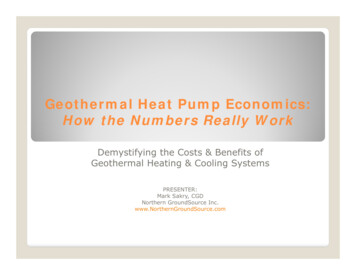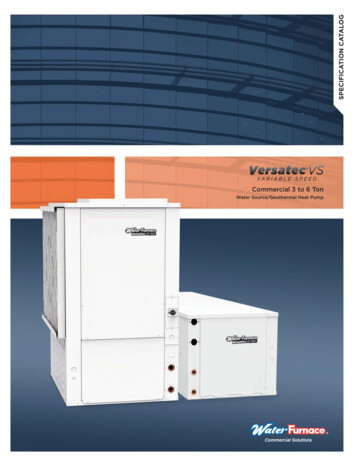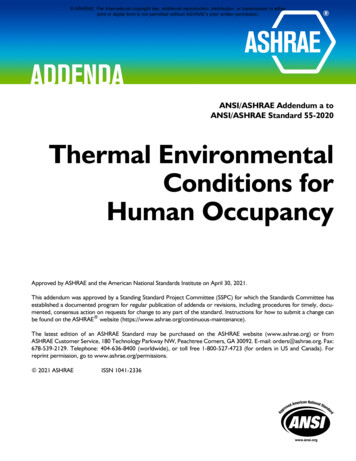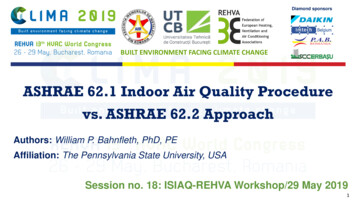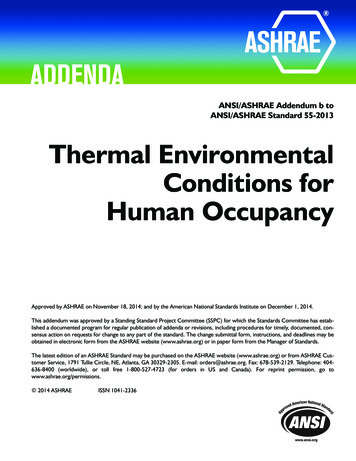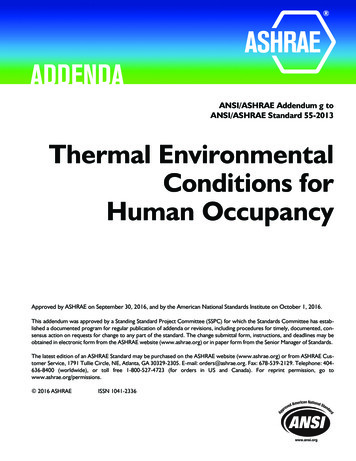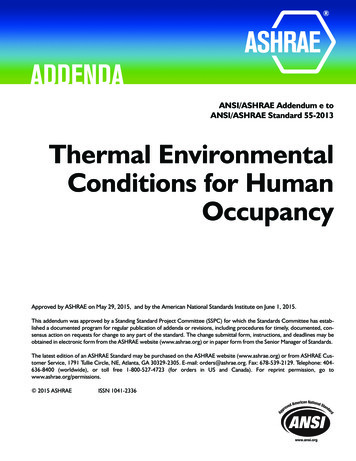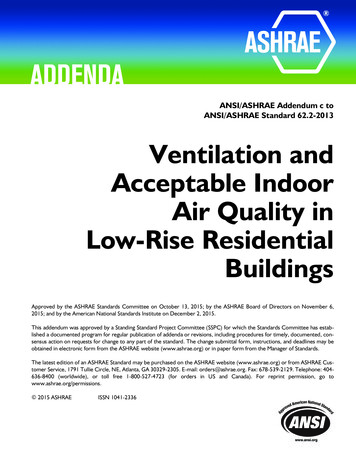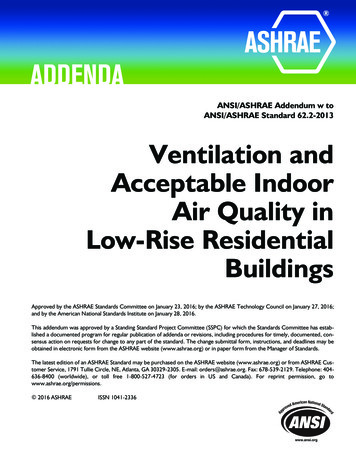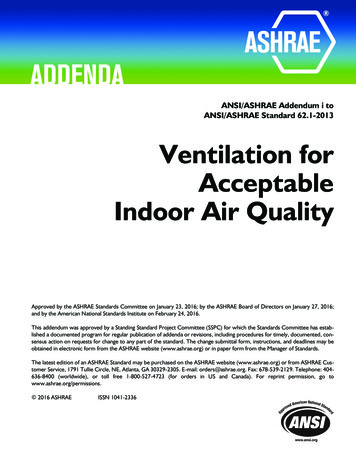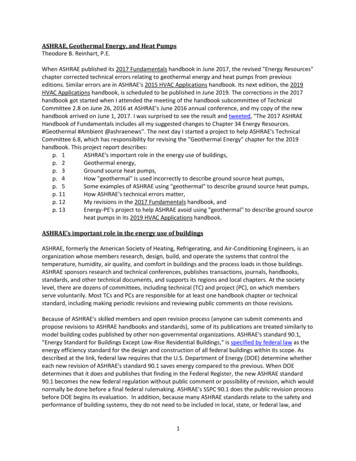
Transcription
ASHRAE, Geothermal Energy, and Heat PumpsTheodore B. Reinhart, P.E.When ASHRAE published its 2017 Fundamentals handbook in June 2017, the revised "Energy Resources"chapter corrected technical errors relating to geothermal energy and heat pumps from previouseditions. Similar errors are in ASHRAE's 2015 HVAC Applications handbook. Its next edition, the 2019HVAC Applications handbook, is scheduled to be published in June 2019. The corrections in the 2017handbook got started when I attended the meeting of the handbook subcommittee of TechnicalCommittee 2.8 on June 26, 2016 at ASHRAE's June 2016 annual conference, and my copy of the newhandbook arrived on June 1, 2017. I was surprised to see the result and tweeted, "The 2017 ASHRAEHandbook of Fundamentals includes all my suggested changes to Chapter 34 Energy Resources.#Geothermal #Ambient @ashraenews". The next day I started a project to help ASHRAE's TechnicalCommittee 6.8, which has responsibility for revising the "Geothermal Energy" chapter for the 2019handbook. This project report describes:p. 1ASHRAE's important role in the energy use of buildings,p. 2Geothermal energy,p. 3Ground source heat pumps,p. 4How "geothermal" is used incorrectly to describe ground source heat pumps,p. 5Some examples of ASHRAE using "geothermal" to describe ground source heat pumps,p. 11How ASHRAE's technical errors matter,p. 12My revisions in the 2017 Fundamentals handbook, andp. 13Energy-PE's project to help ASHRAE avoid using "geothermal" to describe ground sourceheat pumps in its 2019 HVAC Applications handbook.ASHRAE's important role in the energy use of buildingsASHRAE, formerly the American Society of Heating, Refrigerating, and Air-Conditioning Engineers, is anorganization whose members research, design, build, and operate the systems that control thetemperature, humidity, air quality, and comfort in buildings and the process loads in those buildings.ASHRAE sponsors research and technical conferences, publishes transactions, journals, handbooks,standards, and other technical documents, and supports its regions and local chapters. At the societylevel, there are dozens of committees, including technical (TC) and project (PC), on which membersserve voluntarily. Most TCs and PCs are responsible for at least one handbook chapter or technicalstandard, including making periodic revisions and reviewing public comments on those revisions.Because of ASHRAE's skilled members and open revision process (anyone can submit comments andpropose revisions to ASHRAE handbooks and standards), some of its publications are treated similarly tomodel building codes published by other non-governmental organizations. ASHRAE's standard 90.1,"Energy Standard for Buildings Except Low-Rise Residential Buildings," is specified by federal law as theenergy efficiency standard for the design and construction of all federal buildings within its scope. Asdescribed at the link, federal law requires that the U.S. Department of Energy (DOE) determine whethereach new revision of ASHRAE's standard 90.1 saves energy compared to the previous. When DOEdetermines that it does and publishes that finding in the Federal Register, the new ASHRAE standard90.1 becomes the new federal regulation without public comment or possibility of revision, which wouldnormally be done before a final federal rulemaking. ASHRAE's SSPC 90.1 does the public revision processbefore DOE begins its evaluation. In addition, because many ASHRAE standards relate to the safety andperformance of building systems, they do not need to be included in local, state, or federal law, and1
designers do not need to be ASHRAE members, to be responsible for designing in compliance with otherASHRAE standards, for example ASHRAE's standard 62.1 "Ventilation for Acceptable Indoor Air Quality."Geothermal EnergyGeothermal energy describes thermal energy sources within the Earth, collectively resulting in arelatively tiny average outward energy flow, with distinct causes unrelated to solar or ocean tidal powerat the surface. Geothermal energy adds heat to the millions-of-years-long processes of transformingorganic deposits into fossil fuels. In the Earth's crust, heat is generated by the natural fission (decay) ofradioactive elements. The mantle is hotter than the crust, and the core is hotter than the mantle,resulting in a net heat flow outward from the mantle up through the crust. While natural radioactivedecay may still be present in the mantle and the core, most of the heat from below the crust is the slowcooling of the core from the much higher temperature when the Earth formed over four billion yearsago, still making its way out through the thin insulation of the lithosphere. The mantle transfers heatfrom the core to the crust by convection and conduction. The two main sources of geothermal energyare the heat transfer from hotter regions below the crust and the heat of radioactive decay in the crust,resulting in a mean continental geothermal power flux of 0.062 W/m2 and a mean oceanic flux of 0.101W/m2. The global mean is about 0.09 W/m2 and the total geothermal power of the Earth at the surfaceis about 44 Terawatts (TW).The geothermal power flux at the Earth's surface is insignificant compared to the mean absorbed solarpower and atmospheric infrared radiation (IR). If geothermal power was the only source heating theEarth's surface (no Sun or atmospheric IR) the surface temperature would be near 35 K based on theglobal mean geothermal power flux. Instead, because of solar radiation and the atmosphere with itsnatural "greenhouse effect," the mean surface temperature of the Earth is about 288 K (15 C) resultingin a mean radiated heat loss of about 390 W/m2, over 4000 times the geothermal power flux.Geothermal energy has no effect on the surface or near-surface temperature of the Earth, which is aresult of the Sun, the "greenhouse effect," and the heat capacity/thermal diffusivity of the soil, water,and rocks near the Earth's surface. Infrared radiation from the surface of the Earth is nearly 200,000 TW.The primary sources of data on temperatures and thermal properties of the Earth's crust aremeasurements of the geothermal gradient within continental boreholes and ocean sediment cores, andlaboratory analysis of the thermal properties of core samples. For continental temperatures near thesurface, diurnal oscillations in ground temperature, due to diurnal oscillations in air temperature, areobserved within the top 1 to 2 meters, the amplitude decreasing with depth. Annual oscillations inground temperature, due to annual oscillations in air temperature, are observed to a depth of 19 to 38meters, the amplitude also decreasing with depth. Below this depth the annual oscillations at thesurface are no longer noticeable and the undisturbed ground temperature is about equal to the localmean air temperature, the midpoint of both the diurnal and annual oscillations.Without geothermal energy, the mean surface temperature would determine the temperature withinthe Earth. At some depth below where annual oscillations in ground temperature disappear, climatedifferences would also eventually decrease to zero, resulting in a uniform deep Earth temperature of288 K (15 C). Instead, with geothermal energy, below the depth where diurnal and annual temperatureoscillations go to zero, the mean continental geothermal gradient of 20 to 30 C/km becomesmeasurable. For example, for a local climate temperature of 288 K, the temperature at 100 metersdepth due to climate temperature would be 288 K. With a local geothermal gradient of 20 C/km, an2
additional contribution from geothermal energy flux would be 2 K, for a total temperature of 290 K. Thisis below the depth of the ground loops of most ground source heat pump systems.Ground source heat pumpsA ground source heat pump (GSHP) is a heat pump which uses the ground as its low-temperaturereservoir (heat source) and uses a heating load as its high-temperature reservoir (heat sink). Heat pumpsare often reversible, meaning the cycle can be switched from heating to cooling, using a cooling load asits heat source and the ground as its heat sink. Using the ground, rather than air, as a heat pumpsource/sink for heating/cooling can improve efficiency because local ground temperature (below 19meters) is relatively constant and about the local mean air temperature (the local climate temperature),in contrast to the outdoor air temperature, which changes with the weather and experiences diurnaland annual hot and cold extremes.Being decoupled from weather extremes, a GSHP's higher installed cost can often be justified by itshigher efficiency, with resulting lower energy cost and/or lower peak power demand, when comparedto an air source heat pump (ASHP). Building heating and cooling loads follow the weather, meaningheating loads increase when the outdoor air gets cooler and cooling loads increase when the outdoor airgets hotter. The highest heating and cooling loads occur during the lowest and highest outdoor airtemperatures, respectively, when ASHP heating and cooling capacities and efficiencies are at theirlowest. A GSHP can use the ground, groundwater, or surface water at a relatively constant temperaturebecause those source/sinks have a high heat capacity which dampens and time shifts the effects ofdiurnal and annual outdoor air temperature oscillations over days (below 1 meter) and years (below 19meters). For most climates, GSHPs are among the most efficient, and lowest peak demand, spaceheating and cooling systems compared to other systems using the same source of work (for example,electricity).A GSHP is usually a packaged, space conditioning, reversible, all-electric heat pump connected to theground by a buried, closed-loop, polyethylene piping system of supply and return headers connected toone, or usually more, U-tubes, dropped and grouted into uncased vertical wells spaced about 7 metersapart and drilled to a depth of 30 to 120 meters. This formula estimates the pipe friction heating power:Watts 746 x GPM x deltaP / 3960.For example, one U-tube made of nominal 3/4-inch diameter pipe, serving a one ton cooling load, has aflow of 3 GPM. For a U-tube 75 meters deep (150 meters of pipe), the deltaP is 8 feet of water column.Using the formula, the frictional heating of the heat transfer fluid in one U-tube is 4.52 Watts. For a gridwith 49 m2 per well, the average frictional heat gain per square meter of well field is 0.092 W/m2. Thisformula is based on a loop filled with water and neglects any heat from the circulating pump or thepressure drop through the heat pump evaporator, so it is a low estimate. Usually the ground loopcontains a mixture of water and anti-freeze and its higher viscosity will result in a greater deltaP andmore frictional heating power.Coefficient of performance (COP) is a measure of efficiency for a heat pump for a given set of operatingconditions, the ratio of useful heating energy supplied divided by useful energy used (for example,electricity), and GSHP manufacturers publish performance data for GSHPs. For example, theWaterFurnace model NS036 (ECM blower option, p.35) with an entering water temperature (EWT) of 60F at 9 GPM and an entering air temperature of 70 F, has a heating capacity (HC) of 36,200 BTU/H, anelectric input of 2030 W, heat extracted (HE) of 29,200 BTU/H, and a COP of 5.23. Interpolation withdata for 70 F EWT implies increasing the EWT by 1 K (1.8 F) to 61.8 F would increase HC, HE, kW, and3
COP values to 36,900 BTU/H, 29,900 BTU/H, 2.04 kW, and 5.31, implying a 1 K average increase inambient ground temperature from the geothermal gradient might make a 0.07, or 1.5%, improvementin the COP.The reason for the discrepancy between this predicted performance improvement (1.5%) from anaverage 1 K geothermal gradient boost over the depth of the ground loop and what is really happeningin a closed-loop system is because elevated ground temperature from the geothermal gradient near thesurface is a result of the ground being undisturbed by thermal effects other than climate andgeothermal power flux over thousands of years. The heat extracted by the NS036 (3-ton nominal) GSHPat 60 F is 29,200 BTU/H (8560 W). For a 49 m2 per ton well field, the average annual power flux of theGSHP heat extracted by this single-speed heat pump is 13 W/m2, 1.5 orders of magnitude less than theclimate power flux, but over two orders of magnitude greater than the geothermal power flux. TheGSHP ground flux includes a load factor correction for 2000 hours in heating mode and 1000 in coolingmode. In cooling mode the NS036 rejects 41,900 BTU/H (12,280 W) to the ground loop field. This is anannual average power flux of about 10 W/m2 of surface area into the ground and also two orders ofmagnitude greater than the geothermal power flux. The GSHP annual cycle of extracting heat in thewinter and rejecting heat in the summer is so large it obliterates any effect geothermal power flux hadon steady-state undisturbed temperatures in the ground loop field. Local undisturbed temperature at adepth below annual oscillations is the integration of thousands of years of the local climate boundarycondition at the surface, and geothermal energy no longer affects ground temperature when a GSHPbegins disturbing it on diurnal and annual timescales with its powerful heating and cooling loads.How "geothermal" is used incorrectly to describe ground source heat pumpsThe word "geothermal" is used incorrectly to describe ground source heat pumps, ignoring one or bothof these two facts,1. Geothermal power has no effect on local ambient ground temperature.2. A heat pump's low-temperature reservoir isn't useful energy.Ignoring either fact leads to false claims. The first is making the false claim that the Earth's geothermalpower flux affects local ground (climate) temperature, a widespread confusion. The second is makingthe false claim that a heat pump's low-temperature reservoir, lik
When ASHRAE published its 2017 Fundamentals handbook in June 2017, the revised "Energy Resources" chapter corrected technical errors relating to geothermal energy and heat pumps from previous editions. Similar errors are in ASHRAE's 2015 HVAC Applications handbook. Its next edition, the 2019 HVAC Applications handbook, is scheduled to be published in June 2019. The corrections in
